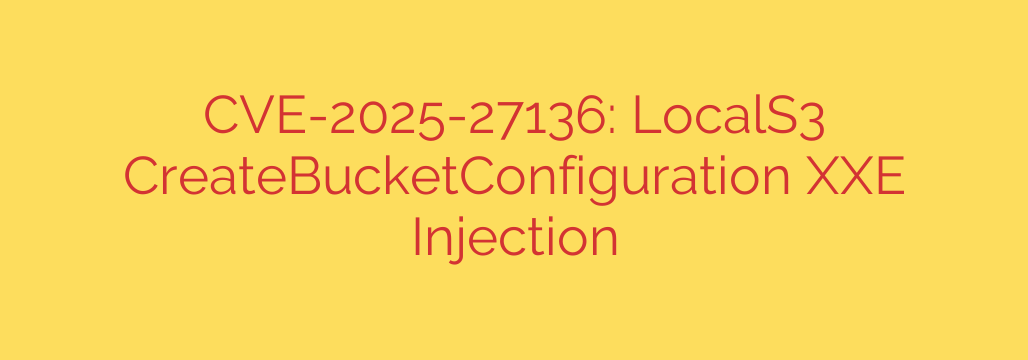
Securing Your Development Environment: A Deep Dive into the LocalS3 XXE Vulnerability (CVE-2025-27136)
A critical security vulnerability has been identified in LocalS3, a popular S3-compatible service used for local development and testing. Tracked as CVE-2025-27136, this flaw allows for an XML External Entity (XXE) injection, posing a significant risk to the security of the underlying server where LocalS3 is running.
If you use LocalS3 in your development or testing pipelines, understanding this vulnerability and taking immediate action is crucial.
What is an XXE Injection Vulnerability?
At its core, an XML External Entity (XXE) injection is a type of web security vulnerability that allows an attacker to interfere with an application’s processing of XML data. Many applications use XML to transmit data between the browser and the server. If the XML parser is poorly configured, it can be tricked into executing malicious requests by an attacker who embeds them within a standard XML payload.
In the case of CVE-2025-27136, the vulnerability lies specifically within the CreateBucketConfiguration function of LocalS3. When a user creates a new S3 bucket, they can specify a location constraint via an XML body. An attacker can craft a malicious XML payload for this request that, when processed by LocalS3, can lead to serious security breaches.
The Impact: What Can an Attacker Do?
Exploiting this XXE flaw can grant an attacker several dangerous capabilities, turning a local development tool into a gateway for compromising your system. The primary risks include:
- Sensitive File Disclosure: The most common impact of XXE is unauthorized file access. An attacker could potentially read sensitive files from the server’s local file system. This includes files like
/etc/passwd, application source code, configuration files containing passwords or API keys, and private SSH keys. - Server-Side Request Forgery (SSRF): The vulnerability can be leveraged to perform SSRF attacks. This means the attacker can force the server running LocalS3 to make requests to other internal network services that are not typically accessible from the outside. This can be used to scan internal networks and attack other services.
- Denial of Service (DoS): By referencing an endless stream of data or a file that recursively includes itself, an attacker can overwhelm the XML parser. This can cause the LocalS3 service to crash, leading to a denial of service that disrupts development and testing workflows.
Are You Affected?
This vulnerability affects all versions of LocalS3 prior to the latest patched release. The flaw can be exploited by any user or service that has permission to send a CreateBucket request to the LocalS3 instance.
Even though LocalS3 is primarily a development tool, many teams integrate it into automated CI/CD pipelines or expose it within a containerized network. Any instance that is reachable by a potentially untrusted actor should be considered at risk.
Actionable Steps for Mitigation and Remediation
Protecting your systems from CVE-2025-27136 requires immediate action. Follow these security best practices to secure your LocalS3 instances.
Update Immediately: The most effective solution is to update your LocalS3 installation to the latest version. The developers have released a patch that correctly configures the XML parser to disable external entity processing, completely neutralizing the threat. Check the official repository for the latest secure version.
Apply Workarounds if Unable to Update: If you cannot update immediately, you must implement mitigation strategies. The primary workaround is to manually configure the XML parser used by your application to disable DTDs (Document Type Definitions) and external entities. This prevents the parser from acting on malicious instructions.
Practice Network Segmentation: As a general security principle, never expose development tools like LocalS3 to the public internet. Ensure it is only accessible within a trusted, firewalled network environment. Restrict access to the service to only the specific IP addresses of developers or CI/CD runners that require it.
Review Application Dependencies: This vulnerability is a stark reminder of the importance of regularly auditing and updating your project’s dependencies. Use automated tools to scan for known vulnerabilities in your software supply chain and maintain a policy of keeping all components up-to-date.
By understanding the risks associated with CVE-2025-27136 and taking swift, decisive action, you can ensure your development and testing environments remain secure and resilient against attack.
Source: https://www.offsec.com/blog/cve-2025-27136/








